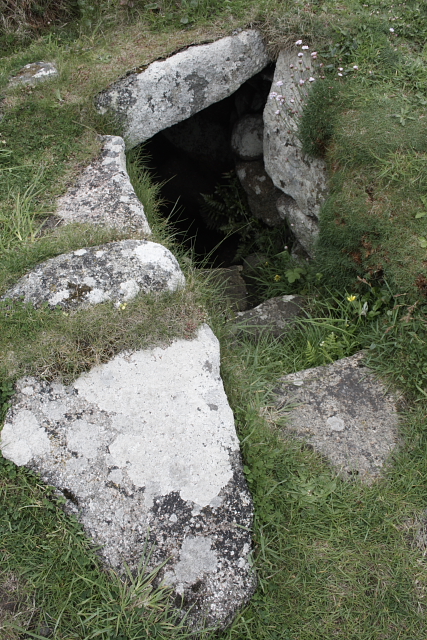OS grid reference: SP 0435 2779. About 1 mile east of Winchcombe village, Gloucestershire, on the side of a hill stands St Kenelm’s holy well. The wellhouse-cum-baptistry which houses the holy well is a mid-16th century building. The well takes its name from St Kenelm, a Mercian boy-king and martyr, who was the grandson of King Offa. He was ‘most treacherously’ murdered at the instignation of his scheming elder sister, Quendrida, sometime between 819-821 AD. It is located on the side of a hill which is surrounded by trees on its lower sides, and is easily reached along a country lane that runs in an easterly direction out of Winchcombe village, passing close by Sudeley Castle. A footpath runs just to the west of the well-house. The holy well was a place of pilgrimage in the Middle Ages and in more recent times too, as was Winchcombe Abbey, where the martyr’s coffin had lain for many hundreds of years. It is now housed in St Peter’s parish church.
Francis Duckworth recalls the “Legend of St Kenelm” in his beautiful book ‘The Cotswolds’, and says: “Kenulf, King of Mercia, founded Winchcombe Abbey in the 9th century. He had a daughter, Quenride, and a son, much younger, Kenelm. The latter, while still a child, succeeded his father, and the jealous Quenride at once began to hatch plots to put him out of the way. One fine morning he went out hunting with his tutor, and never returned. So Quenride reigned in his stead.
“Some years afterwards, while the Pope was celebrating mass in St Peter’s, a pure white dove flew in through an open window, and let fall a piece of parchment from her bill. On the parchment was written: “In Clent, in Cowbach, Kenelm, Kinges bermn (bairn) lieth under a thorn heuade birevede (bereft of his head).” An Englishman who happened to be present interpreted this, and the Pope set on foot an investigation of the whole matter. In the end a party of monks from Winchcombe succeeded in finding the headless of Kenelm. At this point the monks of Worcester interfered, and claimed the body as having been found within their boundaries. Divine arbitration was implored. Both claimants should sleep one night by the body’s side: the first to wake should possess the relic. This good fortune fell to the Winchcombe monks. On their way they stopped to rest, and the spot is marked by St Kenelm’s Well.”
St Kenelm’s murder took place at Romsley in the Clent Hills, Worcestershire, where another holy well sprang forth where the saint’s body had lain. This well is located in the valley behind St Kenelm’s church, which is about½ a mile north-west of the village, according to authors Janet & Colin Board ‘Sacred Waters’. On its long journey from Romsley in Worcestershire the martyr’s body had been rested, only a mile from Winchcombe Abbey, Gloucestershire, but this simple action caused a second spring of water to burst forth and soon miracles of healing were attributed to its water. The well water was said to be most effective as a cure for eye troubles. Above the door of the stone-built wellhouse is a statue of St Kenelm, who today surveys what would have been his kingdom, but sadly ‘that’ wasn’t to be. The present-day building dates from 1549 and it was restored in 1887.
Author Francis Duckworth goes on to say that after Kenelm’s murder: “Quenride sat at her window to watch the procession pass, and, to cast an evil spell upon it, read aloud the 100th Psalm backwards. When the procession reached her window her eyes dropped out of her head into her lap, and stained the psalter with blood. This psalter was preserved and shown for many years in proof of the story. Kenelm was buried in the abbey precincts, and one of the two very early stone coffins in the west end of the parish church is called Kenelm’s coffin.” The other coffin was thought to be that of King Kenulf (Coenwulf), father of St Kenelm (Cynehelm). Winchcombe abbey was founded by King Kenulf in 789 or 798 AD, but it was dissolved in 1539. Nothing survives of the abbey above ground. The evil Quenride, also known as Cwenthryth lived out the rest of her ‘sad’ days in a monastery, where she was ‘perhaps’ made abbess? She died in 827 AD. St Kenelm, the boy-king, is still much venereated at Winchcombe – where is feast-day is held on 17th July.
Over the years there has been much speculative debate on the age of Kenelm when he succeeded his father to the throne of Mercia. We can assume that he came to the throne in either 819 or 821 AD at the age of 7 or 9, if he was born in 812 AD which is the date usually given, although some historians think he was a few years older than that, maybe as old as 12? Not that it really matters now!
Sources:
Bord, Janet & Colin, Sacred Waters, Paladin, London W1, 1986.
Bottomley, Frank., The Abbey Explorer’s Guide, Kaye & Ward, Tadworth, Surrey, 1981.
Duckworth, Francis., Beautiful Britain – The Cotswolds, A. & C. Black Ltd., Soho Square, London W1, 1914.
http://www.geograph.org.uk/photo/2767417 © Copyright Michael Dibb and licensed for reuse under this Creative Commons Licence.
https://insearchofholywellsandhealingsprings.wordpress.com/2012/03/19/st-kenelms-well-at-winchcombe/



















